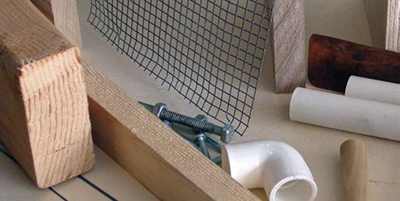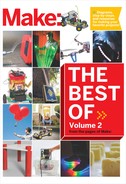Stock Your Shop
Be ready with a basic inventory of the stuff dreams are made of.
By William Gurstelle
In my Barrage Garage workshop, I keep frequently used materials on hand at all times. Stocking a well-considered selection of materials is important when I need to make a simple model or a fast prototype to bring an idea to life, or at least prove to myself that it’s worth further exploration.
Choosing materials is an important part of any project. But tradeoffs abound and it can be tricky to decide which raw material is right for the job. One material may be strong, but difficult to machine. Another may be great for use indoors but lose its integrity when placed in the elements.
Over time, I’ve developed an inventory of basic raw materials that enable me to start, and sometimes even complete, a great variety of projects without the need to visit a lumberyard or wait for the UPS truck.
Dimensional Lumber
Dimensional lumber is the wood commonly sold in lumberyards. It’s sized according to standardized widths and depths that are nominally described in whole numbers, but its actual size is ¼" or ½" less than described. For example, a 1×2 board is actually ¾"×1½".
Dimensional lumber comes from softwoods like fir and pine. Cut into 2×4s, it’s commonly used for building the frame or supporting structure of a project. Shelves and smaller objects are frequently made from 1"-thick (nominal) boards of various widths and lengths.
It’s inexpensive and versatile, so keep ample supplies on hand for spur-of-the-moment projects. I like to stock:
1×2×8’ (4)
1×4×8’ (4)
2×4×8’ (4)
Engineered Wood
Engineered wood products are manufactured from wood components and adhesive. Strong and light, they’re just the thing for covering walls and roofs, and they’re useful for projects of all types. Engineered woods include the old standby, plywood, as well as particleboard and medium-density fiberboard (MDF).
MDF and particleboard are manufactured from wood pulp and glue pressed into sheets. They’re easy to cut and sand, a plus for the inexperienced maker. They’re cheaper than plywood, and not as prone to warping.
Plywood, on the other hand, is proportionally lighter and stronger than MDF and particleboard. It holds fasteners more securely, and has far better moisture resistance. Plywood comes in a variety of thicknesses; 3/8" and 5/8" are the most commonly used.
Engineered wood comes in 4‘×8’ sheets that can take up a lot of storage space. If that’s a problem, cut the sheets in half. Stock:
5/8" plywood, B or C grade, 4‘×4’ sheets (2) or a 4‘×8’ sheet if you have room
Dowels
When dimensional lumber is too big, dowels (cylindrical rods made from solid wood) are utilitarian wonders. They’re great for aligning, fastening, and supporting project parts. Stock:
¼" dowel, 3’ lengths (4)
3/8" dowel, 3’ lengths (4)
½" dowel, 3’ lengths (2)
Hardware Cloth and Expanded Metal
Hardware cloth is wonderfully useful stuff. It’s a sheet of stiff, galvanized steel wire welded into a regular square mesh. Flexible and strong, it’s perfect for screening off large areas inexpensively.
Expanded metal is a rigid, open mesh made from sheet metal that has been slit and expanded. It is much stronger and more rigid than hardware cloth.

MATERIAL WORLD: Having a well-stocked selection of basic materials makes it possible to build (and photograph) on the fly.
You can use these materials for animal-proofing, providing support for materials such as plaster or concrete, making guards for dangerous areas, and more. Expanded metal is strong enough to be walked upon. Stock:
Hardware cloth, ¼" mesh,
2‘×4’ sheet (1)
Expanded metal, 2‘×4’’ sheet (1)
Angle Iron aka Structural Steel
Structural steel or iron, like dimensional lumber, is most often used to build a frame or superstructure. The many types of structural steel are described by the shapes they make when looking at them on-end—angles, channels, bars, I-beams, and more. Angle iron is the king. It’s relatively inexpensive, extremely strong, and can be attached to other pieces of iron by fasteners or by welding.
I keep several 8’ pieces of galvanized 14-gauge slotted angle iron on hand. Although its galvanized surface makes it nearly unweldable, it’s still wonderfully versatile. The slots allow pieces to be cut and joined easily using 3/8" bolts and nuts. Channels and I-beams are useful in situations requiring greater stiffness, although they’re heavier and cost more per linear foot. Stock:
S lotted steel angle, 1¼"×1¼"×8’ (2)
Brass Sheet
Brass is an alloy of copper and zinc. Stronger than copper alone, brass sheet is a great prototyping material that can be machined, bent, or cut to close tolerances. It’s easily worked with common hand tools and can be joined by soldering or by mechanical fasteners. Stock:
Brass sheet, .032"×6"×12" (1)
Brass sheet, .016"×6"×12" (1)
Plastic Pipe and Pipe Fittings
Because of its low cost, strength, and easy workability, PVC (polyvinyl chloride) is among the most common plastics in use. PVC pipe comes in many sizes and shapes, with many types of connectors (called fittings). It’s useful for making furniture frames, medium-duty support structures, and plumbing for liquids or air. Stock:
P VC pipe, 1" diameter, 8’ lengths (2) with 1" elbows (4), tees (4) and caps (4)
P VC pipe, 2" diameter, 8’ lengths (2) with 2" elbows (4), tees (4) and caps (4)
Music Wire
Beloved by makers for its ability to be bent and then retain its shape, this tough and springy wire is especially useful in making mechanisms and models. Be forewarned, it’s really tough stuff, requiring a special cutter (or a high-speed rotary tool like a Dremel). Stock:
M usic wire, .056" OD, 3’ lengths (2)
Fasteners
Nearly all projects involve joining parts together, commonly by using mechanical fasteners such as bolts, screws, and nails. Going to the hardware store for every nut and bolt consumes time and fuel, so keep a reasonable selection of fasteners on hand. Stock:
R ound-head or pan-head machine
screws (12 each):
4-40×¼"
4-40×½"
6-32×3/8"
6-32×¾"
8-32×½”
8-32×1"
10-24×½"
10-24×1"
¼-20×¾"
¼-20×1"
Hex-head cap screws (6 each):
¼-20×1½"
¼-20×2"
3/8"-16×1"
3/8"-16×1½"
3/8"-16×2"
3/8"-16×2½"
Nuts (24 each):
4-40
6-32
8-32
10-24
¼-20
3/8"-16
Nails (1 box each): 2d and 8d
